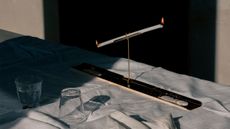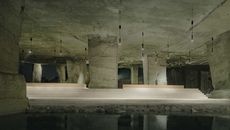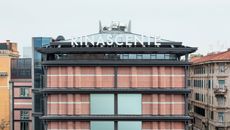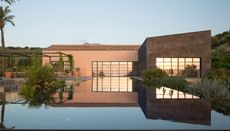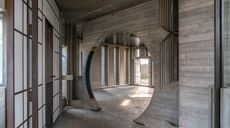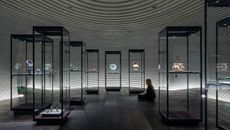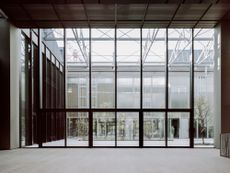Paolo Portoghesi’s postmodernist architecture: curves, Baroque and irony
A love affair with the Baroque, a playful sense of irony, a captivation with curves and a passion for patterns define the life and work of postmodernist Italian architect Paolo Portoghesi
- (opens in new tab)
- (opens in new tab)
- (opens in new tab)
- Sign up to our newsletter Newsletter
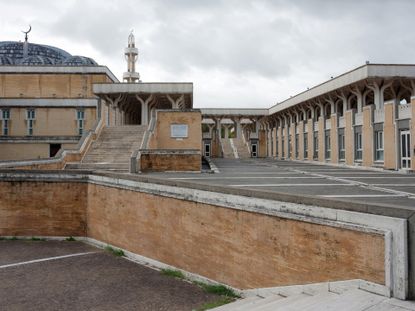
‘Do you know that I’ve always been rather fascinated by wallpaper?’ says Paolo Portoghesi gently, almost as if trying to break the ice. The 89-year-old architect, historian, poet, designer and mercurial icon of modern Italian culture shares a house with wife Giovanna in Calcata, a medieval hilltop town near Rome that has, in recent years, been repopulated by artists. The interiors feature a lot of wallpaper, mostly in patterns by William Morris, covering what empty wall space there is in the various libraries, studies, nooks and awkward anterooms. Everywhere are objects, miniscule and large, sought-after and found by chance, geological and zoological, in equal measure. The almost ludicrously decorative home-cum-museum of a polymath architect and historian might feel oppressive, or at least too strictly preserved in aspic, but this house is far from stuffy. Here, where every inch creates a patterned juxtaposition of past and present, where Portoghesi passes nimbly through the warrens and menageries, everything, including the walls and those Morris prints, seem to be very much alive.
Despite an architectural legacy that spans at least six decades – ranging from the radical, concrete curves of Casa Baldi (1959-61) on the outskirts of Rome to the elaborately sinuous interior of the Mosque of Rome (completed in 1994) – Portoghesi remains a contentious figure in modern Italian architecture. The country’s merciless theorists, often contemporaries, peers and collaborators of Portoghesi, were not always kind. In his History of Italian Architecture 1944-1985, Manfredo Tafuri asserted that Portoghesi’s work showed ‘a taste for excess but lacked any excitement’.

Octogenarian architect Paolo Portoghesi photographed in the gardens of his home in Calcata, Lazio
It is perhaps Portoghesi’s obsessive exploration of Italian, and specifically Roman, Baroque architecture that led to his isolation and categorisation as an adherent of historicism, a doctrine that was the very antithesis of 20th century architecture. Portoghesi was born and raised in central Rome, and the city’s monuments and their makers clearly cast a long shadow. He speaks of the precise moment when, as a young boy, he was struck by the cupola of Francesco Borromini’s 1642 church of Sant’Ivo alla Sapienza, which was near his school. ‘It was problematic for me, but I was enchanted,’ he says. Borromini’s manipulation of geometry and perspective was full of paradoxes, such as the harmony between sharp points and soft curves: ‘I saw that poetry is expressed through architecture.’
The main reception room of the house at Calcata is dominated by a metal and glass screen, fixed on a wall, which provides an alluring backdrop. It is inspired by the false apse of the church of Santa Maria at San Satiro in Milan, which was completed in 1482 and features an early example of trompe l’œil, attributed to High Renaissance architect Donato Bramante. As Portoghesi opens a secret mirrored door within the screen, he marvels at Bramante’s trick of making only nine metres of depth appear to be more like 80.
A playful sense of irony defines Portoghesi’s work and best explains his role as a pioneer of Italy’s postmodernist movement. In 1980, he spearheaded the creation of the first Venice Architecture Biennale, entitled La Presenza del Passato (The Presence of the Past). The fair was centred around the ‘Strada Novissima’ exhibition, for which he wrangled submissions from some of the world’s most prominent architects, among them Frank Gehry, Rem Koolhaas, Arata Isozaki, Robert Venturi and Denise Scott Brown, and Ricardo Bofill. Portoghesi created a street lined with the contributions of each participant architect, and the exhibition is considered by many as a rallying point for the postmodernist movement and certainly one of its most intellectually rigorous manifestations.

Portoghesi's home features a series of steps that echo the geometric patterns found inside Francesco Borromini’s Sant’Ivo alla Sapienza in Rome
‘Sometimes you need a bit of noise and colour in architecture,’ says Portoghesi. During the 1980s, when postmodernism seized the architectural upper hand, he edited the ravishingly eclectic, large-format architectural quarterly magazine Eupalino. Looking inside any of the magazine’s 12 issues is a trip into the mind of the editor and a taste of the spirit of those times. ‘It was an era of optimism,’ he says. ‘Edonismo Reaganiano [Reagan-era hedonism].’ He felt relieved that the privations of modernism were gone. Le Corbusier, according to Portoghesi, managed to create astonishing works of art, but the modernism he spawned lacked expression and ultimately ruined the modern city. Indeed, ‘Strada Novissima’ offered a counter to Le Corbusier, who hated the closed-in ‘rue corridor’ and advocated endless, open streets stretching into the horizon. Portoghesi champions the opposite, saying, ‘It’s the very closing of the street that makes it beautiful. It’s how you create a gathering space.’
Adjacent to the complex of dwellings that forms Portoghesi’s house is an expansive garden containing various follies, fountains, temples and a library, as well as an impeccably-kept zoo. As tropical birds flap and squawk in their elaborate enclosures, he bends down to mimic the quacking of one of the geese that are allowed to roam free. Reflecting on a movement that he acknowledges is once again in fashion, Portoghesi remains enthusiastic: ‘Postmodernism represented liberty,’ he says. ‘It was freedom to explore the past or the future. Of course, liberty is dangerous, it can make you do irrational, absurd things. But we all need a spectacle.'

Taking influences from Baroque and Islamic architecture, Portoghesi played with curves and geometric patterns

Staircase entrance at the Mosque of Rome

The architect created soaring vaulted ceilings and an internal forest of tree-like columns and Ottoman-style hoop chandeliers

Courtyard at the Mosque of Rome

The Sala Portoghesi, at the Terme Tettuccio spa in Montecatini, designed by Portoghesi in 1987

Detail at Sala Portoghesi, at the Terme Tettuccio

Looking up at the ornate ceiling at Sala Portoghesi

Structural detail at Sala Portoghesi, Terme Tettuccio

Casa Baldi (1959), on Via Sirmione on the outskirts of Rome, was built for a film director

For Casa Baldi, Portoghesi took inspiration from the work of 17th century Italian architect Francesco Borromini

Entrance at Casa Baldi by Paolo Portoghesi

Terrace detail at Casa Baldi by Paolo Portoghesi
-
 Design podcasts to discover: creative giants share smalltalk and big ideas
Design podcasts to discover: creative giants share smalltalk and big ideasListen to the best design podcasts by creators, curators and journalists shining a spotlight on different areas of the design practice
By Rosa Bertoli • Published
-
 2022 fashion highlights, as picked by the Wallpaper* team
2022 fashion highlights, as picked by the Wallpaper* teamThe Wallpaper* fashion and beauty team reflect on their personal 2022 fashion highlights – from Gaetano Pesce at Bottega Veneta and Wales Bonner in Florence to intrigue and seduction at Prada
By Jack Moss • Published
-
 Marre Moerel’s swinging flame candle uses artful balance
Marre Moerel’s swinging flame candle uses artful balanceVita Balanza by Marre Moerel and Santa & Cole has turned candles into a balancing act
By Martha Elliott • Published
-
 The Fendi factory in Tuscany disappears into the landscape
The Fendi factory in Tuscany disappears into the landscapeThe new Fendi Factory in Italy, set in the rolling hills of Tuscany, is the brainchild of Milan architecture studio Piuarch and the luxury brand
By Ellie Stathaki • Published
-
 Step inside the dramatic Cava Arcari by David Chipperfield
Step inside the dramatic Cava Arcari by David ChipperfieldCava Arcari by David Chipperfield reimagines a series of caves outside Vicenza as a multifunctional event space
By Ellie Stathaki • Published
-
 Rinascente is reborn in Rome’s Piazza Fiume courtesy of design studio 2050+
Rinascente is reborn in Rome’s Piazza Fiume courtesy of design studio 2050+Rinascente in Piazza Fiume, Rome gets a makeover by Milan-based interdisciplinary design agency 2050+
By David Plaisant • Published
-
 This Sicilian villa brings contemporary architecture to the foot of Mount Etna
This Sicilian villa brings contemporary architecture to the foot of Mount EtnaL House is a modern Sicilian villa in perfect sync with its surroundings, designed by London-based architecture practice Transit Studio
By Ellie Stathaki • Published
-
 Take the ultimate Carlo Scarpa tour of Venice
Take the ultimate Carlo Scarpa tour of VeniceA Carlo Scarpa tour to end all tours; join our survey of modernist buildings by the Italian midcentury master in and around Venice
By Natasha Levy • Last updated
-
 Etruscan Galleries at Fondazione Luigi Rovati by Mario Cucinella just flow
Etruscan Galleries at Fondazione Luigi Rovati by Mario Cucinella just flowIn Milan, the Etruscan Galleries at the Fondazione Luigi Rovati, designed by architect Mario Cucinella, open to the public
By Ellie Stathaki • Last updated
-
 This historical Florentine villa is given a contemporary rethink
This historical Florentine villa is given a contemporary rethinkDanish design brand Frama and filmmaker Albert Moya have worked together to update the Villa Medicea di Marignolle in Italy
By Hannah Silver • Last updated
-
 Minimalism and transparency rule at Luxottica’s Digital Factory in Milan
Minimalism and transparency rule at Luxottica’s Digital Factory in MilanLuxottica's Digital Factory by Milan-based architects Park Associati is the latest addition to the city's via Tortona neighbourhood
By Ellie Stathaki • Last updated


